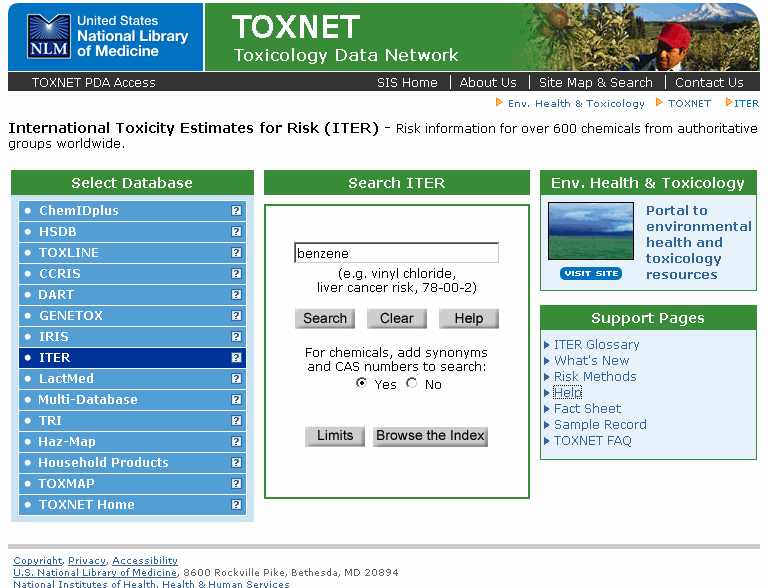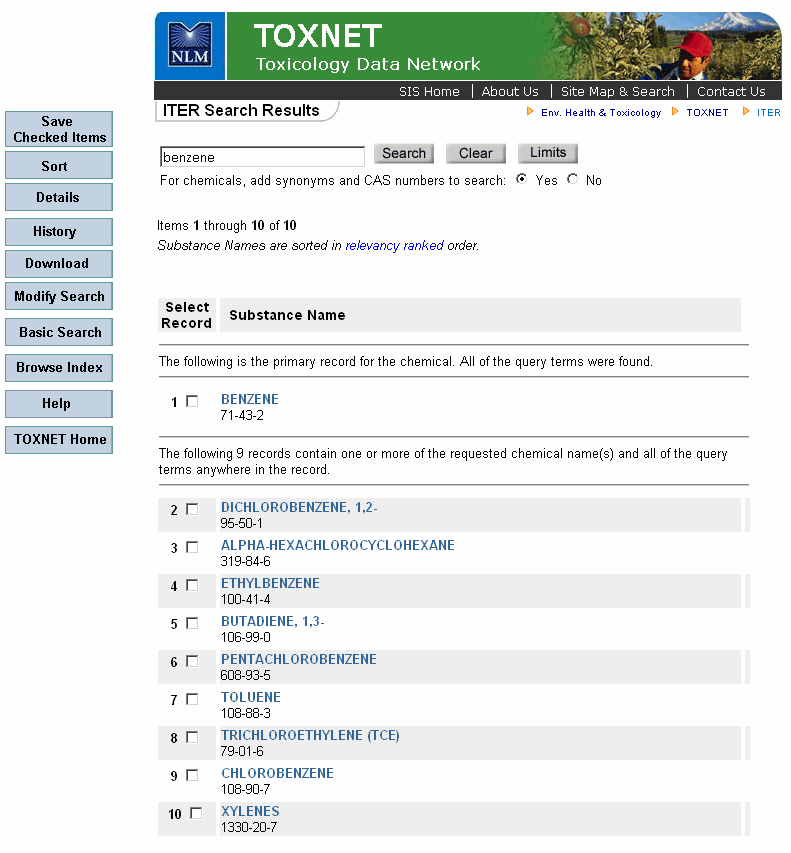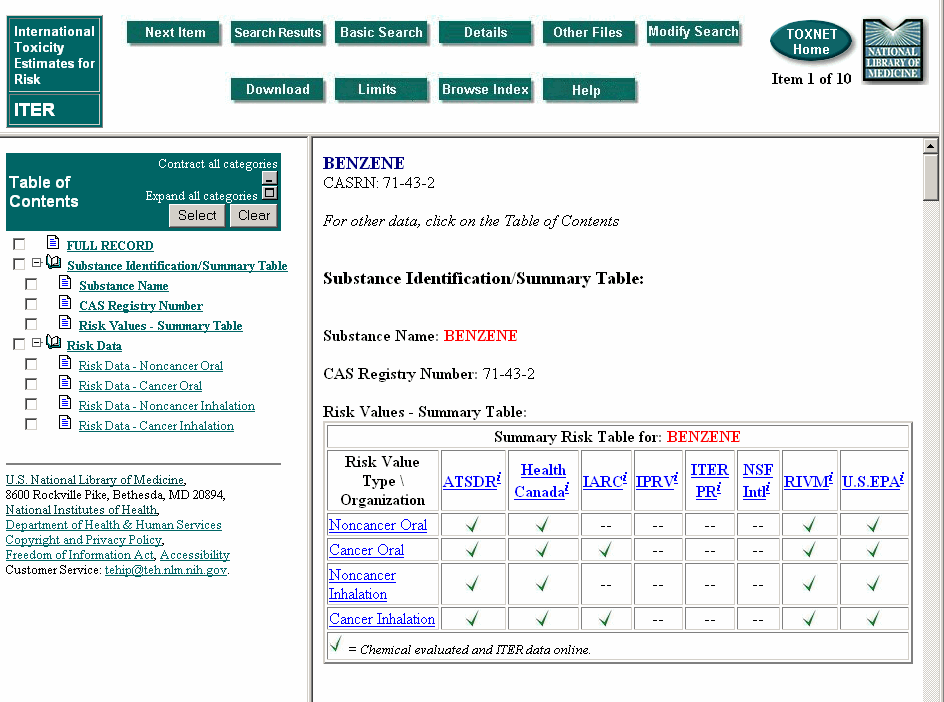TOXNET HELP TEXT - ITER
Contents
SEARCH SCREEN
- Entering a Search Query
- Synonym Searching
- Browse the Index
- Databases
- Other NLM Resources/Support Pages
SEARCH RESULTS
- About Your Search Results
- Save Checked Items
- Sort
- Details
- History
- Download
- Modify Search
- Basic Search
- Browse Index
- TOXNET Home
- Page Navigation
SELECTED RECORD
SCREEN
- About the Selected Record Screen
- Next Item
- Previous Item
- Search Results
- Basic Search
- Details
- Other Files
- Modify Search
- Download
- Limit
- Browse Index
- TOXNET Home
HOW THE SYSTEM
SEARCHES FOR AND DISPLAYS RECORDS
ITER CONTENT
ADVANCED SEARCHING FEATURES
RECOMMENDED
BROWSERS
SEARCH SCREEN

Entering a Search Query
In the query box, enter one
or more terms (e.g., benzene), which describe your search topic. These may be
any combination of words, chemical names, and numbers, including Chemical
Abstracts Services (CAS) Registry Numbers (RN). Common "stop words"
such as "a," "an," "for," "the," and
"it," although you may enter them, will not be searched.
Examples of search terms:
- acetone
- vinyl chloride
- 67-64-1
- 75-01-4
- rat
- liver
- provisional
- lung cancer
- maternal toxicity
The term(s) entered will be
searched for in all ITER fields.
The
search will be initiated when you click the Search button. To erase your
search term(s) and start over with a blank query box, click on the Clear
button.
If your query consists of
chemicals, TOXNET will, by default (i.e., the radio button "Yes"
is selected), expand your search by adding synonyms and CAS Registry Numbers.
Thus, if you enter "perchloroethylene," the system will add the CAS
RN 127-18-4 and synonyms such as "tetrachloroethylene" and
"tetrachloroethene." You have the option to turn off this feature by
selecting the button "No." This will result in a search only
for the exact word(s) you entered. In the example above, the system would then
look only for the word "perchloroethylene."
Browse the Index
[Screen Shot 2 � Browse for Hexachlorobenzene]
[Screen Shot 3 � Results of Browse for Hexachlorobenzene]
Clicking on the Browse the Index button will display
a segment of ITER, beginning with the
term you enter (e.g., hexachlorobenzene), and let you scan the index
alphabetically (or numerically) above or below the original display by clicking
on the Up or Down button. For each index term, the system
displays the number of ITER records
containing that term. By checking the "Check to Select" box(es)
corresponding to the index term(s) of interest and clicking on the Select
button, you can search on the selected term(s). You may browse the index to all
words, CAS Registry Numbers, or chemical names.
Databases(The
Left Column of the Screen)
Clicking on
any of the cells in this column will take you directly to the search screen for
the database selected. "Multi-databases" offers simultaneous
searching of HSDB, CCRIS, IRIS, ITER,
and GENE-TOX. The information icon ("i") next to each database
provides a brief description of it, with links to a more detailed Fact Sheet
and a sample record.
Other NLM
Resources, Support Pages� (The Right
Column of the Screen)
You may also visit
additional NLM Web-Based Resources:
- DIRLINE - Directory of health and scientific organizations.
- Tox Web Links - Links to additional toxicology
Web sites.
- MEDLINEplus Tox/Env Health - Consumer health
information on toxicology and environmental health topics.
- PubMed - Access to the MEDLINE database of
biomedical literature.
- NLM Gateway - Searches across multiple NLM
databases.
- Locatorplus - NLM's online catalog of books,
audiovisuals, and journals.
Or Support
Pages:
- Help - Detailed documentation, such as what you are
reading now, about searching TOXNET.
- Fact Sheet - Provides an expanded description of ITER.
- Sample Record - A look at a sample ITER record.
�����������
SEARCH RESULTS
About Your Search Results

Your initial retrieval is
displayed as a list of chemical names, highlighted in blue and underlined, and
their CAS Registry Numbers. If your search was for a chemical (e.g., benzene)
and there is a match for it in the database, the record for this chemical,
referred to as the primary chemical record, will display first, followed by a
list of other chemical records which also contain some mention of the chemical
you entered. This latter list of chemicals is displayed according to a Relevancy
Ranking algorithm. Clicking directly on any of the items will provide a
display of the Selected Record Screen, containing all the data, for that item.
If your query consists of
words that are not chemical terms, this same Relevancy Ranking algorithm
determines the order of display of all your search results, with the most
relevant results displaying first.
By
checking one or more of the numbered boxes to the left of the list of records,
you can perform operations, such as downloading, on these selections at a later
time.
You can alter your search,
if you choose, directly in the query box, which reappears on this page with
your search terms. Alternately, you can use the Modify Search button,
described below.
The vertical series of
buttons on the left side of the Search Results page offers a variety of
options:
Save Checked Items� This is used to create a subset of
your search results. First check the records you want to save, then click on Save
Checked Items. The system confirms the number of items you saved and lets
you display just these references by clicking on a new button - Display
Saved Items - which is added to the series of buttons.
Sort�
Sort all or some of the
records alphabetically (in ascending or descending order) by substance name .
�
Details�
Summarizes the strategy
used by TOXNET to perform your search. This will include your query terms plus
any synonyms or CAS Registry Numbers added by the system.
History� Reviews your search session by
itemizing your search statements, numbering them sequentially, and listing the
number of records retrieved. Clicking on History allows you to view
earlier search result sets or combine these sets provided they are within the
same database.
Download� You can download all or some of the
records in "brief" or "full" formats and select particular
categories of information (custom formats).
Modify Search� Return to the Basic Search screen
with your search strategy retained. You can make changes or perform a new
search at this point.
Basic Search � Return to the Basic Search screen
with the query box cleared. You can now enter a new search.
Browse Index � This feature displays a segment of
the HSDB index, beginning with the term you enter, and lets you scan the index
alphabetically (or numerically) above or below the original display by clicking
on the Up or Down button. For each index term, the system
displays the number of HSDB records containing that term. By checking the
"Check to Select" box(es) corresponding to the index term(s) of
interest and clicking on the Select button, you can search on the
selected term(s). You may browse the index to all words, CAS Registry Numbers,
or chemical names.
TOXNET
Home � Return to the TOXNET Home Page.
Page Navigation
The top and bottom of each
Search Results page displays the total number of pages, the current page
number, the total number of items, and the items displayed on the current page.
You can navigate through multi-page search results by specifying a page number
and clicking on the "Go" button or by using the blue arrows to go to
the following or preceding page(s).
SELECTED RECORD SCREEN
About
the Selected Record Screen

This screen displays the
record for whichever item you selected on the Results Screen. If you searched
for a chemical (e.g., benzene) and clicked on the "Primary Record" of
the Search Results Screen, you will see the full ITER record, along with a
Table of Contents frame on the left. If you clicked on a chemical record other
than the primary one, the sections of the record best matching your query terms
will be displayed (see Best Sections), again with an accompanying Table of
Contents. From the Table of Contents, you can choose to view the entire ITER record or portions thereof (by
expanding and contracting categories, and checking categories and/or fields)
for the chemical you selected.
If your original search was
for a term other than a chemical, any chemical record you click on from the
Search Results Screen will result in a "Best Sections" display.�
The search term(s) you
entered, as well as synonyms (if you selected to search for them), will all be
highlighted in red wherever they appear in the text of the selected chemical
record.
Across the top of the
screen is a series of buttons with more options:
Next Item � Move forward for a display of the
next item (if there is one) in your search retrieval or saved items set.
Previous Item - Move backward for a display of the
previous item (if there is one) in your search retrieval or saved items set.
Search
Results � Return to the Search Results display.
Basic
Search � Return to the Basic Search screen with the query box cleared so
that you can enter a new search.
Details
� Displays a summary of the strategy you specified for your search and synonyms
added by the system.
Other
Files � Link directly to records in other TOXNET data or bibliographic
files (e.g., CCRIS,
IRIS, TOXLINE) containing information on your selected chemical.�
Modify
Search � Return to the Basic Search screen with your search strategy
retained.� You can make changes or
perform a new search at this point.
Download
� You can download the selected record in �full� format and select a particular
category of information (custom format).
Limits -Boosts search precision over the Basic Search interface by allowing you to specify a particular field or category of fields in which you want your search term to appear.
Browse Index � This feature displays a segment of the HSDB index,
beginning with the term you enter, and lets you scan the index alphabetically
(or numerically) above or below the original display by clicking on the Up
or Down button. For each index term, the system displays the number of
HSDB records containing that term. By checking the "Check to Select"
box(es) corresponding to the index term(s) of interest and clicking on the Select
button, you can search on the selected term(s). You may browse the index to all
words, CAS Registry Numbers, or chemical names.
TOXNET Home � Return
to the TOXNET Home Page.
HOW
THE SYSTEM SEARCHES FOR AND DISPLAYS RECORDS
TOXNET
searches for your terms, in singular and plural form, throughout all records.
The system will automatically look for synonyms and CAS Registry Numbers of
chemicals unless you choose to disable this feature.
�
If you
search on multiple terms, and each record retrieved contains all the terms you
entered, the system will first display those records in which all the terms
appear in the same section of the record. These records will be followed by
records in which the terms appear in different sections of the record. If a
multiple-term search fails to retrieve any records containing all the terms
entered, the system will display the following message: "No records were
found which contain all of the search words. The following records contain at least
one of the words."
�����������
Relevancy
ranking attempts to determine which documents are most pertinent to the search,
and to place the most relevant documents first in the list of returned
documents. The ranking is based upon the number of individual search terms
occurring in a document, the number of times each search term occurs in a
document, its rarity within the database, and the nearness of search terms to
each other. Documents containing combinations of search words tend to be ranked
higher than documents having isolated occurrences of the words.
In
searching for a particular chemical, say "benzene," your retrieval
may include chemical records in addition to the initial matching chemical
record, called the "primary" record. These additional records appear
if they contain the word "benzene." This might occur, for example, if
the chemical is a metabolite of benzene, interacts with benzene, or has been
tested along with benzene in a toxicity study.�
Clicking on any of these non-primary chemicals on the Search Results
screen will display the Best Sections, those where the chemical search term
appears with greatest frequency. The term searched appears highlighted in red.
In addition, if you search for a chemical, such as �arsenic�, which appears in
ITER as �arsenic, inorganic,� then a Best Sections display will result for
�arsenic, inorganic.��
Another situation in which
Best Sections would occur is in searching for a subject, say
"teratogenicity." In this case, clicking on any of the chemicals in
the Search Results screen will display the Best Sections - i.e., the sections
of the records where the word "teratogenicity" appears with the
greatest frequency.
ITER CONTENT
ITER contains over 620 chemical records,
each of which has four sections of data:�
noncancer oral, cancer oral, noncancer inhalation, and cancer
inhalation.� Each of these sections
provides a summary table of risk data, a synopsis explaining the table and
differences in risk values derived by different organizations, and a further
information section providing additional details and links to each
organization�s Web Site.� ITER provides both risk data and cancer
classifications.� Definitions and
abbreviations can be found in the ITER
Glossary.
A green check
indicates there is data available, while a double dash indicates that data is
not available.
Clicking on an
organization name or acronym (e.g. ATSDR) will take you to that organization's
home page on the Web.
Clicking on the
"i" next to the organization name or acronym will take you to a brief
description of the organization in the "ITER Definitions" list.
Risk data includes a table
representing the particular type of risk (noncancer oral; cancer oral;
noncancer inhalation; cancer inhalation) under discussion, followed by a
synopsis summarizing the results therein, and then followed by specifics
related to values derived by each organization.
ADVANCED SEARCHING FEATURES
Users seeking a finer
degree of precision in retrieval than available through either TOXNET's
standard Basic Search screen or Limits option may want to consider formulating
searches through the use of field qualifiers and/or Boolean logic.
Users seeking a finer
degree of precision in retrieval than available through TOXNET's standard
relevancy ranking methodology may want to consider formulating searches through
the use of field qualifiers and/or Boolean logic.
Boolean Searching utilizes the logical operators OR,
AND, NOT. It is a means of limiting your search of two or more terms to
criteria you specify.� Logical operators
must appear in upper case. Searches containing combinations of these operators are
processed with ANDs taking precedence, followed by NOTs, and then followed by
ORs. This default precedence may be overridden with the use of parentheses,
which may also be nested (i.e., parentheses within parentheses).
- OR - In searching ITER,
for instance, for records containing either the word "liver" or
the word "kidney," you would enter "liver OR kidney."
This would retrieve all records containing either of these words (or both
of them) regardless of the field(s) in which they may appear.
- AND - This operator is used to search for the co-occurrence
of two or more search terms, for example �pulmonary AND edema� would
search for records containing both these terms.
- NOT - This operator allows you to exclude terms from your
search. For instance, to search in ITER for carcinomas that are not squamous
cell, you would enter "carcinoma NOT squamous NOT cell."
- Parentheses - To search for toxic effects
on brain or cerebellum in rats or mice, you would enter "(rats OR
mice) AND (brain OR cerebellum)."
Truncation � The asterisk (*) may be freely used
as a truncation symbol standing for any number of characters. Searching in ITER for "spin* � will retrieve
records with words such as spine, spinal, spino, and spinally in the Human
Toxicity Excerpts field. Truncation may be used with or without Boolean searching.
Phrase Searching � In
phrase searching, quotation marks ("�") are included as part of the
search strategy and are used to search for two or more terms exactly the way
they are entered. In HSDB, you might want to search for records containing the
phrase "liver failure.�� It would
be entered just that way, within parentheses.�
Phrase searching may be used with or without Boolean searching..
RECOMMENDED BROWSERS��
TOXNET is best viewed with Internet Explorer 4.0 or Netscape
4.0 or higher versions, for either PC or Mac.